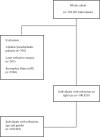Prevalence of Myopia in France: A Cross-Sectional Analysis
- PMID: 26559276
- PMCID: PMC4912270
- DOI: 10.1097/MD.0000000000001976
Prevalence of Myopia in France: A Cross-Sectional Analysis
Abstract
Refractive error (RE), particularly myopia, is the first cause of visual impairment throughout the world. This study aimed to depict the prevalence of myopia in a multicentric series of French individuals.This cross-sectional analysis was carried out between January 2012 and November 2013 in eye clinics dedicated to REs. Data collection included age, gender, best-corrected visual acuity, RE, and any relevant medical history involving laser refractive surgery and cataract surgery. Exclusion criteria consisted of monophthalm patients or those with incomplete demographic data.Prevalences in the overall population, by gender and by age groups were reported for mild myopia (-0.50 to -2.75 diopter [D]), moderate myopia (-3 to -5.75 D), high myopia (less than -6 D), and very high myopia (less than -10 D).The analysis included 100,429 individuals, mean age 38.5 years (± 16.9). Overall prevalence of myopia was 39.1% (95% CI 38.8-39.4). Prevalences of mild, moderate, high and very high myopia were respectively 25.1% (95% CI 25.4-24.9), 10.6% (95% CI 10.4-10.8), 3.4% (95% CI 3.3-3.5) and 0.5% (95% CI 0.48-0.57).Even if possible bias occurred in recruitment, our results are similar to RE data collected in nationally representative samples of Caucasians in other studies. This is to our knowledge, one of the largest European series of individuals dedicated to myopia prevalences in different age groups. These results confirm the importance of myopia as a major health issue in Western countries.
Conflict of interest statement
The authors have no funding and conflicts of interest to disclose.
Figures
References
-
- Sherwin JC, Hewitt AW, Coroneo MT, et al. The association between time spent outdoors and myopia using a novel biomarker of outdoor light exposure. Invest Ophthalmol Vis Sci 2012; 53:4363–4370. - PubMed
-
- Hawthorne FA, Young TL. Genetic contributions to myopic refractive error: insights from human studies and supporting evidence from animal models. Exp Eye Res 2013; 114:141–149. - PubMed
-
- Nebbioso M, Plateroti AM, Pucci B, et al. Role of the dopaminergic system in the development of myopia in children and adolescents. J Child Neurol 2014; 29:1739–1746. - PubMed
Publication types
MeSH terms
LinkOut - more resources
Full Text Sources



